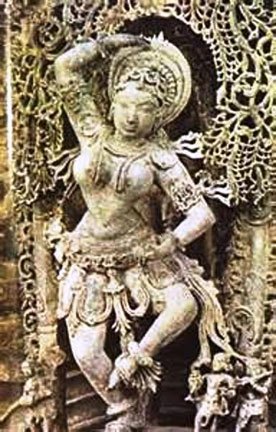The rise and fall of Hindu temple dancers
by Subashini Pathmanathan
Temple dancers in Sri Lanka did not follow any Hindu traditions.
However, they performed in the temple premises and outer verandahs.
Women were supposed to perform in the temples. The male members of this
particular traditional class are still known as Periyamelakarar because
they play the large temple traditional musical instruments called
Natheswaram or Nageswaram and Thavil.
Among all the traditional Tamil musical instruments, Natheswaram and
Thavil are the biggest musical instruments.
 |
|
A Hindu temple dancer
depicted in a sculpture. |
That's why those who play these instruments are often referred to as
Periyamelakarar. The female members were known as Devaradiyarkal or
Sinnamelakaries.
They were supposed to dance at the temple functions. With the passage
of time in Tamil Nadu practising and performing dances at the temples
were banned by the State Legislative Assembly.
Similarly, moderate Hindu Tamil community and several social
reformers of Sri Lanka opposed the practice of dancing at the Hindu
temples due to certain malpractices on many occasions dance programs
ended in disturbances.
Ban
The temple dance performances were stopped at the Arali Muttu Mari
Amman temple in the Jaffna district by the temple manager. It made other
temple administrators in the island follow suit.
Gradually, they also banned the temple dance performances in Sri
Lanka. Many big temples such as Nallur Kandaswamy temple in Jaffna and
Mavidapuram Kandaswamy temple in Kankesanthurai are also gradually
abandoning the tradition.
Many of the temple dancers never adhered to the basic Hindu
traditional norms or moral codes.
They used to eat meat and danced at the temple. Some of them took
alcobolic drinks.
Such misconduct was the main cause of abandoning the dance
performances at temples.
When the big temples abandoned the dances, small village temples took
some time to follow suit. They arranged dance programs mainly to attract
the crowd despite the social stigma.
Nautch girls
During the British era the temple dancers were called as Nautch
girls. They were not considered as a part of temple rituals in Sri
Lanka.
But it was considered more or less as a social practice at the
temples by the people.
At a temple dance held in Mallakam, in the Jaffna district a large
number of people viewed it. The dance continued till the early hours of
the following day.
The dancers were dressed in saris and work heavy makeup. However, the
dances of the Nautch girls were not refined or systematically
structured.
Normally the dances started with an invocation song to Lord Ganesha
following the Hindu tradition. In Hinduism Lord Ganesha is supposed to
be the God of success, worldly wisdom and remover of obstacles. |

